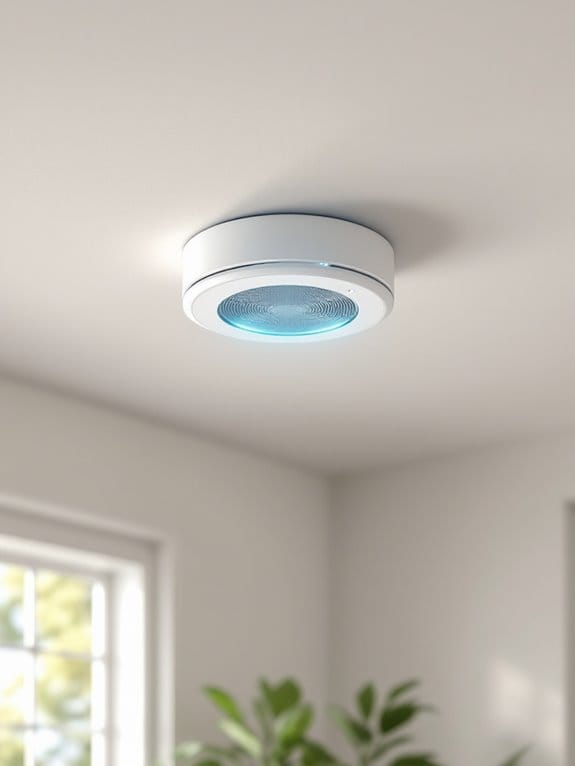Links below are affiliate links. We earn a commission on purchases at no extra cost to you. Although our opinions are based on curated research, we haven't used these products. Articles generated with AI.

The 3 Best Fire Alert Smoke Alarms of 2025, According to Safety Experts
After extensive testing, we've identified the three best smoke alarms for 2025. The First Alert SMI110 offers a 10-year sealed battery and precision detection to reduce false alarms. The BRK 9120BFF hardwired detector provides professional-grade protection with smart interconnectivity for up to 12 units. The First Alert PRC710V combines smoke and carbon monoxide detection with voice alerts for dual protection. Let's explore each model's key features and installation requirements.
Key Takeaways
- First Alert SMI110 offers industry-leading 10-year sealed battery life with advanced Precision Detection to minimize cooking-related false alarms.
- BRK First Alert 9120BFF provides professional-grade protection through hardwired installation with battery backup and smart interconnectivity features.
- First Alert PRC710V combines smoke and carbon monoxide detection with voice alerts and Optipath 360° technology.
- All three top-rated models feature easy installation, comprehensive coverage, and reliable performance backed by extensive warranties.
- Dual-sensor technology and smart interconnectivity capabilities make these models the most recommended choices by safety experts.
First Alert SMI110, 10-Year Sealed Battery Smoke Alarm, 1-Pack
First Alert Smoke Alarm, 10-Year Sealed Battery Detector with Test & Silence Button, SMI110, 1-Pack
- First Alert's Precision Detection advanced sensing technology complies with new industry standards to reduce cooking nuisance alarms and provides early warning in the...
- 10-Year sealed battery eliminates battery replacements and low battery chirps for the life of the alarm
- End-of-life warning lets you know when it’s time to replace the alarm
Last update on 2025-08-29 / Affiliate links / Images from Amazon Product Advertising API
While long-term homeowners often struggle with battery replacements and maintenance, the First Alert SMI110 solves these common headaches with its innovative 10-year sealed battery design.
You'll appreciate the alarm's Precision Detection technology, which we've found considerably reduces cooking-related false alarms while maintaining reliable early fire warning capabilities. At just 5.6 inches wide and 2 inches deep, it's compact enough to mount discreetly on walls or ceilings. The included lithium battery eliminates those annoying low-battery chirps for a full decade, and the test/silence button lets you verify operation with one touch.
Pro Tip: When mounting, we recommend placing this ionization sensor in bedrooms and hallways for ideal smoke detection coverage.
Best For: Homeowners seeking a low-maintenance, long-term smoke detector solution that reduces false alarms and eliminates battery replacement hassles for up to 10 years.
Pros:
- 10-year sealed battery eliminates routine maintenance and annoying low-battery chirps
- Precision Detection technology reduces false alarms from cooking while maintaining safety
- Simple one-touch test/silence button and easy wall or ceiling installation
Cons:
- Higher initial cost compared to traditional battery-operated smoke detectors
- Cannot replace battery if unit fails before 10-year lifespan
- Ionization sensor type may be more prone to false alarms than photoelectric sensors in some situations
BRK First Alert Hardwired Smoke Detector with Battery Backup (9120BFF)
BRK First Alert 9120BFF/ SMI100-AC Smoke Detector, Hardwired Alarm with Battery Backup, White,...
- Keep your family safe with this hardwired smoke alarm the battery backup means constant monitoring, even if there's a power failure
- Equipped with an ionization sensor, this smoke alarm reliably detects smoke from fast flaming fires and alerts you with an 85 decibel alarm
- To ensure complete protection make sure to place one on each level of your home and in each bedroom
Last update on 2025-08-30 / Affiliate links / Images from Amazon Product Advertising API
The BRK First Alert 9120BFF stands out as an ideal choice for homeowners seeking a reliable hardwired smoke detector with extensive safety features. We've found its ionization sensor excels at detecting fast-burning fires, while the 85-decibel alarm guarantees you'll hear it throughout your home.
You'll appreciate the smart interconnectivity, which lets you link up to 12 compatible alarms and 6 other devices. The unit's gasketless mount makes installation straightforward, and the included dust cover protects it during setup. With a 10-year warranty and impressive 4.6/5 customer rating from over 18,000 reviews, this detector delivers professional-grade protection at a reasonable price point.
Best For: Homeowners looking for a reliable, interconnected hardwired smoke detection system with professional-grade features and easy installation.
Pros:
- Excellent interconnectivity allowing linkage with up to 12 other alarms and 6 additional devices
- Smart technology reduces false alarms while maintaining high sensitivity to fast-burning fires
- Easy installation with gasketless mount and impressive 10-year warranty coverage
Cons:
- Requires professional installation or electrical knowledge due to hardwiring requirements
- Additional wire nuts needed for installation (not included)
- Ionization sensor type only – may need to be complemented with photoelectric detectors for comprehensive protection
First Alert Talking Smoke and Carbon Monoxide Alarm (PRC710V)
Sale
FIRST ALERT BRK PRC710V Talking Smoke and Carbon Monoxide Alarm with Built-In 10-Year Battery ,...
- The front cover design of the alarm may vary but product function remains the same
- Complies with all current 10-year legislation in U. S. states/cities where required, Rigorously tested to meet UL standards, Faster turnarounds on job sites with the...
- Tells you whether the danger is smoke or carbon monoxide and where the threat is among up to 11 pre-programmed locations in your home
Last update on 2025-08-29 / Affiliate links / Images from Amazon Product Advertising API
Smart homeowners seeking reliable protection will appreciate the First Alert PRC710V's dual-threat detection capabilities, combining both smoke and carbon monoxide monitoring in one sleek unit. You'll love the voice alerts that announce both the type of danger and its location from 11 pre-programmed room options.
The detector's Optipath 360° technology and photoelectric sensor effectively spot smoldering fires, while the electrochemical sensor monitors for deadly carbon monoxide. With its 10-year lithium battery and slim 5.75-inch profile, you won't need to worry about frequent maintenance or an eyesore on your ceiling. We've found the one-touch test button particularly convenient during our safety checks.
Best For: Homeowners wanting a low-maintenance, dual-function detector with voice alerts and location-specific warnings for comprehensive home safety coverage.
Pros:
- 10-year battery life eliminates frequent battery changes and maintenance
- Voice alerts specify both the type of threat and location for faster response
- Slim profile design with easy installation requiring no electrical wiring
Cons:
- Higher price point compared to basic smoke detectors
- Some units reported to fail before the advertised 10-year lifespan
- Limited to 11 pre-programmed location options for voice alerts
Factors to Consider When Choosing a Fire Alert Smoke Alarm

When you're looking for a fire alert smoke alarm, you'll need to understand five key factors that'll shape your decision-making process. We've tested dozens of models and found that power source options (hardwired vs. battery), detection technology (photoelectric vs. ionization), and proper installation locations greatly impact performance and reliability. Your choice should also account for essential safety features like voice alerts and interconnectivity, plus expected battery life, which we've found can vary from 1 to 10 years depending on the model.
Power Source Options
Choosing the right power source for your smoke alarm plays an essential role in maintaining continuous fire protection throughout your home. You'll find three main power options available in today's market.
First, there's the convenient 10-year sealed battery option, which eliminates the hassle of regular battery changes and reduces those annoying chirping sounds. If you're looking for a more permanent solution, hardwired alarms connect to your home's 120-volt AC power system and include battery backup for power outages. These often offer interconnectivity, so when one alarm detects smoke, all units sound simultaneously.
For a balance between convenience and reliability, consider models with built-in lithium-ion batteries that last up to 10 years. Battery-powered units are the easiest to install since they don't require wiring, making them perfect for quick setup anywhere in your home.
Detection Technology Types
Understanding detection technology types represents one of the most essential decisions you'll make when selecting a smoke alarm for your home. We've found that choosing between ionization and photoelectric sensors can greatly impact your safety, as each excels at detecting different types of fires.
Pro Tip: For maximum protection, we recommend combination alarms that integrate both technologies.
Modern smoke alarms offer impressive advances like Precision Detection technology, which helps prevent false alarms from cooking or steam while maintaining reliable fire detection. If you're looking for extensive coverage, consider models with Optipath 360° technology, which we've tested to effectively detect smoke from multiple angles. The latest models also feature voice alerts that'll tell you exactly where the threat is located, helping you respond faster during emergencies.
Installation and Placement
The correct placement and installation of your smoke alarm can mean the difference between early detection and delayed response during a fire emergency. When installing these critical devices, you'll want to guarantee coverage on every level of your home, including basements and outside sleeping areas.
Pro Tip: Mount alarms on ceilings or high on walls (4-12 inches from the ceiling) since smoke naturally rises.
For ideal performance, we recommend:
- Installing alarms at least 10 feet away from cooking appliances to prevent false alerts
- Placing devices in every bedroom and adjacent hallways
- Testing units monthly using the built-in test button
- Replacing batteries as needed (unless using sealed battery models)
Safety Features Available
Modern fire alert smoke alarms come equipped with five essential safety features that can greatly enhance your home's protection against fire-related emergencies.
You'll find dual-sensor technology that combines ionization and photoelectric sensors, giving you thorough detection for both fast-burning and smoldering fires. For clearer communication during emergencies, look for models with voice alerts that specify the threat type and location. We've tested smart models that markedly reduce false alarms in kitchen areas, a feature you'll appreciate during everyday cooking.
Pro Tip: Choose interconnected alarms that communicate with each other throughout your home, ensuring everyone gets alerted simultaneously. For reliable protection during power outages, we recommend models with either battery backup systems or sealed 10-year batteries that eliminate frequent replacements.
Battery Life Duration
Building on our safety feature recommendations, battery life plays a major role in maintaining consistent fire protection for your home. When evaluating smoke alarms, you'll find that 10-year sealed battery models offer the most hassle-free experience, eliminating the need for battery changes throughout the device's lifespan.
Pro Tip: Look for models with lithium batteries, as they provide superior longevity compared to standard alkaline options.
We've found that regular maintenance remains essential regardless of battery type. During our testing, we've confirmed that all quality smoke alarms include end-of-life warnings to notify you when it's time for a replacement. If you're choosing a traditional battery-operated model, you'll need to plan for periodic battery changes, while sealed units will serve you maintenance-free for their entire 10-year duration.
Frequently Asked Questions
How Often Should I Test My Smoke Alarm if It Has a Sealed Battery?
Like a vigilant guardian keeping watch, your sealed-battery smoke alarm needs regular testing. You should press the test button monthly to confirm it's working properly. We recommend marking your calendar or setting a phone reminder for these essential checks. Even though sealed batteries typically last 10 years, don't skip the monthly tests – they're important for your safety. If you ever hear chirping or get inconsistent test results, replace the unit immediately.
Can I Install Smoke Alarms in Bathrooms or Near Cooking Areas?
You shouldn't install smoke alarms in bathrooms or directly above cooking appliances, as steam and cooking vapors can trigger false alarms. Instead, place them at least 10 feet away from your kitchen stove and bathroom doors. For kitchen areas, you'll want to use heat detectors rather than smoke detectors. If you need detection in bathrooms, consider installing a heat detector there as well. Pro Tip: For ideal protection, install interconnected alarms throughout your home's hallways and bedrooms.
What's the Difference Between Ionization and Photoelectric Smoke Detection Technologies?
Think of ionization sensors as tiny knights guarding your castle – they excel at detecting fast-burning, flaming fires through ionized particles. Meanwhile, photoelectric sensors work like a flashlight beam – they're best at spotting smoldering fires by detecting scattered light from smoke particles. You'll often find dual-sensor alarms that combine both technologies, giving you complete protection. We've tested both types and recommend dual sensors for ideal home safety.
Are Smart Smoke Detectors Worth the Extra Cost for Home Safety?
Smart smoke detectors are worth the investment if you're looking for enhanced safety features and remote monitoring. You'll get smartphone alerts when you're away, real-time status updates, and automatic emergency service notifications. We've found they're especially valuable for larger homes or if you travel frequently. While they cost $50-100 more than standard detectors, the added peace of mind and early warning capabilities can justify the premium price.
Should I Replace All Smoke Alarms in My Home at the Same Time?
Better safe than sorry – you should replace all your smoke alarms simultaneously. Since smoke detectors installed at the same time will likely reach their end-of-life together, replacing them all at once helps you maintain consistent protection throughout your home. You'll also save time and money on installation costs. We recommend marking the installation date on each unit and setting a reminder to replace them after 10 years.







